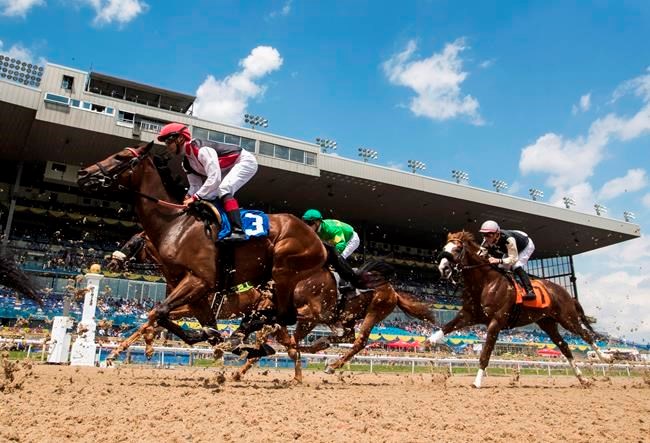TORONTO — The COVID-19 pandemic resulted in a change of dates for Canada's Triple Crown races but it wasn't going to force Jim Lawson to switch either the order or distances of the three events.
The American Triple Crown begins Saturday with the Belmont Stakes, which is traditionally the series finale, without fans. And due to the novel coronavirus outbreak, the Belmont — which was originally scheduled for June 6 — will cover 1 1/8 miles instead of the traditional 1 1/2 miles on dirt at Belmont Park in Elmont, N.Y.
The Kentucky Derby, usually the American series opener in May, will be run Sept. 5 at Churchill Downs in Louisville, Ky. The Preakness — traditionally the middle race — will complete the Triple Crown on Oct. 3 at Pimlico in Baltimore.
The pandemic did force a change in dates for the Canadian Triple Crown but the race sequence remains the same. The Queen's Plate will again open the series on Woodbine Racetrack's tapeta course Sept, 12 rather than June 27.
The Prince of Wales Stakes will go Sept. 29 at Fort Erie Racetrack in Fort Erie, Ont. The Triple Crown will culminate with the Breeders' Stakes turf race Oct. 24, also at Woodbine.
And all three races are currently slated to be run without spectators.
The Canadian Triple Crown races will cover their usual distances (1 1/4 miles for the Plate, 1 3/16 miles on dirt for Prince of Wales at Fort Erie and 1 1/2 miles for the Breeders' at Woodbine). Also, the traditional spaces between all three events have pretty much been maintained.
Lawson, the CEO of Woodbine Entertainment, said keeping the race sequence, time between events and distances uniform wasn't done by accident.
"I think and believe tradition is so important in the sport of horse racing," Lawson said. "It's what people expect, it's what horse people expect and are used to and I think you don't want to lose that continuity.
"When we were talking in March, one of the most important things we were going to do was try and find a way to run the Queen's Plate this year. We're very proud of it being the longest continuously run stakes race in North America and we were going to find a way to do it.
"Some of that same thinking goes into the fact you want a Triple Crown, you want it in the same sequence, you want that tradition of what it is."
If a horse wins the '20 U.S. Triple Crown, there will be many who'll suggest it come with an asterisk as a result of the changes made.
Mark Casse, Canada's top trainer an unprecedented 12 times, will have a horse — Tap It to Win — in Saturday's race. The Casse-trained Sir Winston captured last year's Belmont.
"I've always said training race horses is like putting a puzzle together," Casse said during a conference call Monday. "This year it's been putting a puzzle together with no edges or a picture, it's been crazy.
"I'm just happy we're going to have a Belmont, we're going to have a Preakness and a Derby. Whatever order it's in, I'm fine with that."
What makes Canada's Triple Crown unique is the three races are run on different surfaces, thus creating a very demanding test for horses.
Only seven horses have won Canada's Triple Crown. Wando was the last to achieve the feat in 2003 with jockey Patrick Husbands, trainer Mike Keogh and owner Gus Schickedanz.
"The Canadian Triple Crown is different with the three surfaces and personally again, I don't think you want to start playing with distances," Lawson said. ""The real test (in U.S. Triple Crown) is the 1 1/2 mile race on that Belmont track at the end after a gruelling Kentucky Derby and Preakness.
"What's very complimentary about it, though, is having to keep a horse in shape that long, from June to Oct. 3. There's a lot to be said about that, actually."
This report by The Canadian Press was first published June 15, 2020.
Dan Ralph, The Canadian Press


